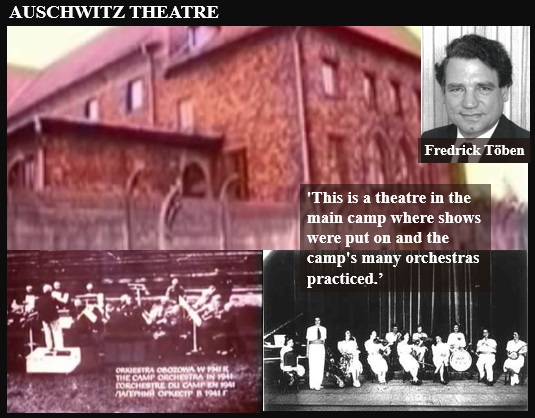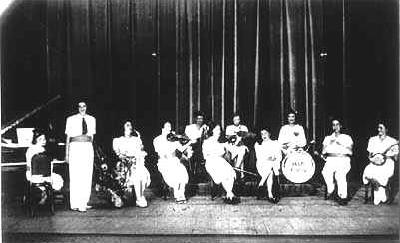
Töben, Fredrick
Auschwitz theatre
[back] Auschwitz-Birkenau
[A theatre at a death camp? Films?]
[vid] Holohoax Survivors who Tell the Truth
Hunt, Eric
'Holohoax Survivors Who Tell The Truth' has really hit a nerve. It's
shocking to hear Auschwitz inmates tell about their elaborate stage, with
curtain rings and a grand piano, where they had plays and other musical
performances. It's shocking to see video of happy children playing in
Theresenstadt juxtaposed with a woman telling about fun costumed children's
plays in her Auschwitz block, along with arts and crafts activities, with
beautiful children's murals painted on the walls. According to the official
Holocaust narrative, all children were immediately gassed upon arrival!
"Testimony" such as this is extremely important to cast doubt on the "factory of
death" Holocaust promoters push. Auschwitz and Buchenwald inmates speak
about being paid for their work in special currency, using their currency in
camp cantinas and at the camp movie theater, receiving and sending postcards,
and playing in well organized soccer tournaments.
Quotes
Christophersen attended
concerts in Auschwitz on Sundays where there was a weekly concert held under the
camp gate by internees who were professional musicians. Anyone could listen to
the concert who was walking around. (20-4960)
[Thies Christophersen] The 'False News' Trial of Ernst
Zündel -- 1988
'Auschwitz had up to 16 camp orchestras (with instruments available), a camp theatre (where live plays were performed by camp inmate actors), camp sculpture classes (conducted for interested inmates by professional sculptors), camp art classes for inmates, a camp university (with lectures on topics from health, the arts, philosophy, science, economic issues, etc.). Marriages took place (worker inmates fell in love and were allowed to marry their inmate partners there). It had its own Auschwitz maternity ward (over 3,000 live births were registered there, with not a single infant death while Auschwitz was in operation under German rule). The women sections of the camp had female guards. It had a camp post office (with twice weekly pick-ups and deliveries). Check this one out: it even had its own jail (for inmates who committed crimes against another inmate). This next one was a big surprise: it even had a "Camp complaints office” where inmates could register complaints or make suggestions. Camp Commander Höss had a standing order that any inmate could approach him personally to register a complaint about other inmates such as "Kapos" and even guards. It had a system of strict discipline for guards and also for inmates, with punishment being handed out against those found guilty for even slapping an inmate. Etc., etc. Er... is anyone still reading? Or is this too disturbing a subject matter?'----The Human Face of Holocaust Revisionism. A Biographical Reminiscence by Chris Crookes
A map taken from a book by former Auschwitz inmate Maximillian Kobler was, to Felderer's knowledge, the only map of the camp to indicate the theatre as a theatre, and to label the alleged gas chamber, not as a gas chamber, but as a crematory, which, in Felderer's opinion, it actually was. [Ditlieb Felderer] The 'False News' Trial of Ernst Zündel -- 1988
He never saw a prisoner die at Auschwitz-Birkenau, nor did he believe the
Jews were treated any differently from the rest of the prisoners.......Christophersen
attended concerts in Auschwitz on Sundays where there was a weekly concert held
under the camp gate by internees who were professional musicians. Anyone could
listen to the concert who was walking around. (20-4960) ....Christophersen
was never under any prohibition not to discuss things at Birkenau with anyone in
civilian life. (20-4965) Although he lived 500 metres from the railroad to
Auschwitz- Birkenau, he never noticed anything with regard to the transports
which struck him. (20-4964) His wife visited him frequently in Auschwitz and
that his mother also came. (20-4941)
....Christophersen knew Birkenau had crematories and
had seen them from the outside. (20- 4947) But he never saw smoke or flames
shooting out of the chimneys nor did he ever smell the alleged stench of human
bodies. (20-4948) He did not know the number of crematories. (21-5005) He only
heard about the gas chamber allegation after the war. (20-4949)
[Thies Christophersen] The 'False News' Trial of Ernst
Zündel -- 1988
The theatre in Auschwitz I was used by the inmates to put on plays and contained a stage and musical instruments. Felderer decided to investigate the large building after an Auschwitz tour guide told him the building was unimportant and was only used by the Germans to put garbage into. Museum officials Piper and Czech later confirmed to Felderer that the building was used as a theatre during the war. Survivor accounts such as Fania Fenelon's Playing for Time also spoke of the Auschwitz orchestra. A large blow-up of a photograph of the orchestra playing during the war was displayed at the Auschwitz Museum at the main entrance. Felderer also showed a slide of a Ukrainian choir singing in what Felderer believed was the theatre building. The photograph was taken from the Dürrfeld file of the United States Archives. Dürrfeld, who had worked at Monowitz, was later charged with war crimes and entered the photographs in his defence.1 (18-4270 to 4273) [Ditlieb Felderer] The 'False News' Trial of Ernst Zündel -- 1988
At Auschwitz today tourists were shown documentary films taken by the Soviets at the liberation of the camp in the same room where inmates had watched films during the war. Piper told Felderer that the seats in the cinema were identical to those used by the inmates. (19-4413) [Ditlieb Felderer] The 'False News' Trial of Ernst Zündel -- 1988
Source: John Ball's page here (shown below)
Theater in the camps
|
| Music programs hand-drawn in 1943 by camp inmates, with
paintings of a concert hall and an interior stage, together with
advertising for the Strauss opera "Die Fledermaus" and "Mozart music".
The list of instruments includes a piano. Most large German camps had concert halls where inmates organized regular Saturday night theater productions, operas, and dances attended by thousands of fellow-inmates. These concerts were the envy of villagers outside camp who did not have the instruments or halls for such gatherings. At times villagers were invited and enjoyed the productions alongside camp inmates. (Programs on display at Mauthausen camp)
|
|
|
| Inmates arranged weekly music, singing, and theatre productions which were attended on Saturdays and Sundays by inmates of all camps in the Auschwitz area. Inmates entered from the visible door while workers and families of other camps and also villagers entered from the main door on the other side of the building. Up to 8 repeat performances a day were necessary to accommodate everyone. The only larger hall was in the Catholic church at Oswiecim town 2 kms (1.2 mi) north. (photo: 1987) |
|
|
| No photos are known to exist of Auschwitz theatre productions but there are photos of other camp groups. The translation of this is: "After the group disbanded in 1941, all of the Jewish Cultural Group artists worked at different camps in acting groups or choirs. This is a 1943 production in Westerbork Camp; here the actress Camilla Spira appeared in many shows. |
